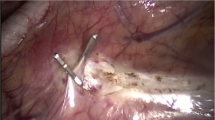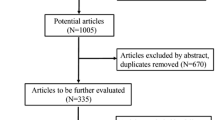Abstract
Purpose
Primary hyperhidrosis is an excessive sweating due to an overactive sympathetic system. Our objective was to test the feasibility and provide early data on the safety/efficacy of CT-guided sympatholysis, for primary hyperhidrosis.
Materials and Methods
Nine consecutive patients with axillary–palmar hyperhidrosis were treated between 2013 and 2015. CT-guided sympathetic block was performed in the outpatients at T-2, T-3, and T-4, bilaterally using alcohol under local anesthesia. Immediate postprocedure CT was obtained to assess the complications as per Common Terminology Criteria for Adverse Events, version 4. Technical success and clinical success were recorded. Primary and secondary efficacy were assessed by phone and clinical visits; mean follow-up was 12 months (6–26 months). Descriptive statistics was used to report the outcomes.
Results
One procedure was aborted due to eyelid ptosis after lidocaine injection. All other eight patients (5:3, F:M) (median age 32) had immediate cessation of sweating. Two major complications (pneumothorax, one requiring a chest tube) occurred. Two patients recurred with unilateral and one with bilateral symptoms. One of the unilateral recurrence and the bilateral recurrence patients was retreated successfully. Median follow-up was 1 year. No cases of Horner’s or compensatory hyperhidrosis were observed.
Conclusions
CT-guided EtOH sympatholysis for axillary/palmar primary hyperhidrosis is feasible. Technical failure rate was 11 %. Primary and secondary efficacy are 75 and 94 %, respectively, to a median follow-up of 1 year. Risk profile appears favorable. Despite a small sample size, results confirm feasibility and encourage a larger study.



Similar content being viewed by others
References
Thorlacius L, Gyldenlove M, Zachariae C, Carlsen BC. Distinguishing hyperhidrosis and normal physiological sweat production: new data and review of hyperhidrosis data for 1980–2013. Int J Dermatol. 2015. doi:10.1111/ijd.12822. [Epub ahead of print].
Grunfeld A, Murray CA, Solish N. Botulinum toxin for hyperhidrosis: a review. Am J Clin Dermatol. 2009;10(2):87–102.
Canadian agency for drugs and technologies in health. Laser therapy for hyperhidrosis: A review of the clinical effectiveness and guidelines. http://www.ncbi.nlm.nih.gov/pubmed/?term=Canadian+Agency+for+Drugs+and+Technologies+in+Health.++Lase+therapy+for+hyperhidrosis%3A+A+review+of+the+clinical+effectiveness+and+guidelines. 2015, PMID: 26180877.
Ong W, Lee A, Tan WB, Lomanto D. Long-term results of a randomized controlled trial of T2 versus T2-T3 ablation in endoscopic thoracic sympathectomy for palmar hyperhidrosis. Surg Endosc. 2015, PMID 26150222 [Epub ahead of print].
Horma Babana H, Lucas A, Marin F, Duvauferrier R, Rolland Y. Evaluation of the efficacy of CT guided thoracic sympatholysis to treat palmar hyperhidrosis French. J Radiol. 2004;85(1):21–24.
Glaser DA, Pariser DM, Hebert AA, Landells I, Somogyi C, Weng E, Brin MF, Beddingfield F. A prospective, nonrandomized, open-label study of the efficacy and safety of Onabotulinum toxin A in adolescents with primary axillary hyperhidrosis. Pediatr Dermatol. 2015;32(5):609–17.
Lakraj AAD, Moghimi N, Jabbari B. Hyperhidrosis: anatomy, pathophysiology and treatment with emphasis on the role of botulinum toxins. Toxins. 2013;5:821–40.
Augustin M, Radtke MA, Herberger A, Kornek T, Heigel H, Schaefer I. Prevalence and disease burden of hyperhidrosis in the adult population. Dermatology. 2013;227:10–3.
Rajagopal R, Mallya NB. Comparative evaluation of botulinum toxin vs iontophoresis with topical aluminum chloride hexahydrate in treatment of palmar hyperhidrosis. Med J Armed Forces India. 2014;70:247–52.
Purtuloglu T, Atim A, Deniz S, Kavakli K, Sapmaz E, Gurkok S, Kurt E, Turan A. Effect of radiofrequency ablation and comparison with surgical sympathectomy in palmar hyperhidrosis. Eur J Cardiothorac Surg. 2013;43(6):e151–4.
Joo S, Lee GD, Haam S, Lee S. Comparisons of the clinical outcomes of thoracoscopic sympathetic surgery for palmar hyperhidrosis: r4 sympathicotomy vs R4 sympathetic clipping versus R3 sympathetic clipping. J Thorac Dis. 2016;8(5):934–41.
Zhang B, Li Z, Yang X, Li G, Wang Y, Cheng J, Tang X, Wang F. Anatomical variations of the upper thoracic sympathetic chain. Clin Anat. 2009;22(5):595–600.
Romano M, Giojelli A, Mainenti PP, Tamburrini O, Salvatore M. Upper thoracic sympathetic chain neurolysis under CT guidance. A two year follow-up in patients with palmar and axillary hyperhidrosis. Radiol Med. 2002;104(5–6):421–5.
Hynes Cf, Seevaratham S, Gesuwan K, Margolis M, Marshall MB. The efficacy of oral anticholinergics for sympathetic overactivity in a thoracic surgery clinic. J Thorac Cardiovasc Surg. 2016. doi:10.1016/j.jtcvs.2016.03.092. [Epub ahead of print].
Author information
Authors and Affiliations
Corresponding author
Ethics declarations
Conflict of interest
There authors declare no conflicts of interest.
Rights and permissions
About this article
Cite this article
Tsitskari, M., Friehs, G., Zerris, V. et al. CT-Guided, Ethanol Sympatholysis for Primary Axillary–Palmar Hyperhidrosis. Cardiovasc Intervent Radiol 39, 1722–1727 (2016). https://doi.org/10.1007/s00270-016-1429-8
Received:
Accepted:
Published:
Issue Date:
DOI: https://doi.org/10.1007/s00270-016-1429-8




